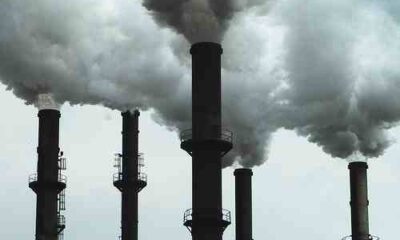

Environment
FFI’s Annual Report shows carbon emissions remain over 460% of World Carbon Budget
The report on 200 of the largest fossil fuel companies focuses on investors, proving carbon emissions remain over 460% of world carbon budget
FFI, a provider of financial research and products for investors seeking to understand, measure, and act on climate risks, today launched their third annual report, The Carbon Underground 2016: Managing the Climate Risks of Fossil Fuel Companies. The report analyses the past year’s changes to The Carbon Underground 200TM (CU200), FFI’s list of the top publicly-traded coal, oil, and gas reserve owners ranked by the potential carbon emissions of their reported reserves. An analytical piece for investors and for anyone concerned about climate change, the report states that the CU200 companies own reserves that equate to 474 gigatons (Gt) of potential CO2 emissions. Although this number is down from the February 2015 number of 555 Gt, FFI emphasises that the potential future reserve-based emissions from CU200 companies remain over 460% of their allocated carbon budget to the year 2050¹. FFI collaborator and leading advisor on sustainability-related portfolio risks, South Pole Group, has provided a discussion of carbon footprinting for the report, including a carbon footprint of the CU200 based on estimated emissions from operations.
The report highlights that investor activity motivated by the financial risks of climate change has surged, accelerated by the success of the 21st UN Climate Change Conference of the Parties (COP 21) and other high-profile climate actions. The report details recent actions in the areas of divestment and shareholder engagement, and provides an overview of several other strategies that climate-focused investors can utilise to manage risk and generate returns. FFI CEO and report co-author Christopher Ito observes: “As more investors assess the impacts of a transition to a low-carbon economy, divestment, engagement, risk management, and active portfolio management will all be viewed as appropriate and even complementary responses to climate risk.”
South Pole Group’s Partner for the Financial Industry and report co-author Maximillian Horster adds: “We are pleased to complement The Carbon Underground annual report with an in-depth emission analysis of the assessed companies and a carbon footprint measurement. It is important to offer the investment community as many tools as possible to fully embrace and combat the intricate risks posed by climate change — understanding one’s carbon footprint is a first step for every climate impact assessment.”
It is important to offer the investment community as many tools as possible to fully embrace and combat the intricate risks posed by climate change.
Specific report findings on the fossil fuel industry show:
- Most of the decline in potential future emissions has been in coal, as a result of significant coal reserves becoming uneconomic. Oil and gas emissions declined only slightly on the oil side and rose slightly on the gas side.
- Coal usage appears to be on a permanent, steady decline in the US and Europe, but the picture in Asia is much more complex and uncertain. While clean energy use is growing in China and India and China has announced mine closures and permit moratoria in some provinces, coal production across Asia has increased overall.
- Oil and gas emission trends demonstrate that a shift in emissions away from oil and towards natural gas is in progress.
- The largest Russian oil companies have shown an increase in production and exploration overall.
The top 10 coal and top 10 oil and gas companies in the CU200 are listed in the report. The entire 2016 CU200 list is available for non-commercial purposes to asset owners, not-for-profit organizations, and members of the media at no cost, and is available quarterly by paid subscription for asset managers and consultants. Eligible users can download the list on the company website. For more information, visit http://www.fossilfreeindexes.com/.
¹This is the number required for the world to have an 80% chance to stay below a 2°C (3.6° F) temperature, according to Intergovernmental Panel on Climate Change (IPCC) models.


 Features9 months ago
Features9 months agoWhat is the Eco-Friendliest Option to Wash Your Dishes?

 Environment12 months ago
Environment12 months agoBuilding a Career in Green Construction: Tips and Insights

 News11 months ago
News11 months ago5 Ways Fleet Maintenance Software Can Help Businesses Be More Eco-Friendly

 Features10 months ago
Features10 months agoAddressing Pressing Ethical Concerns with Crypto Exchanges























